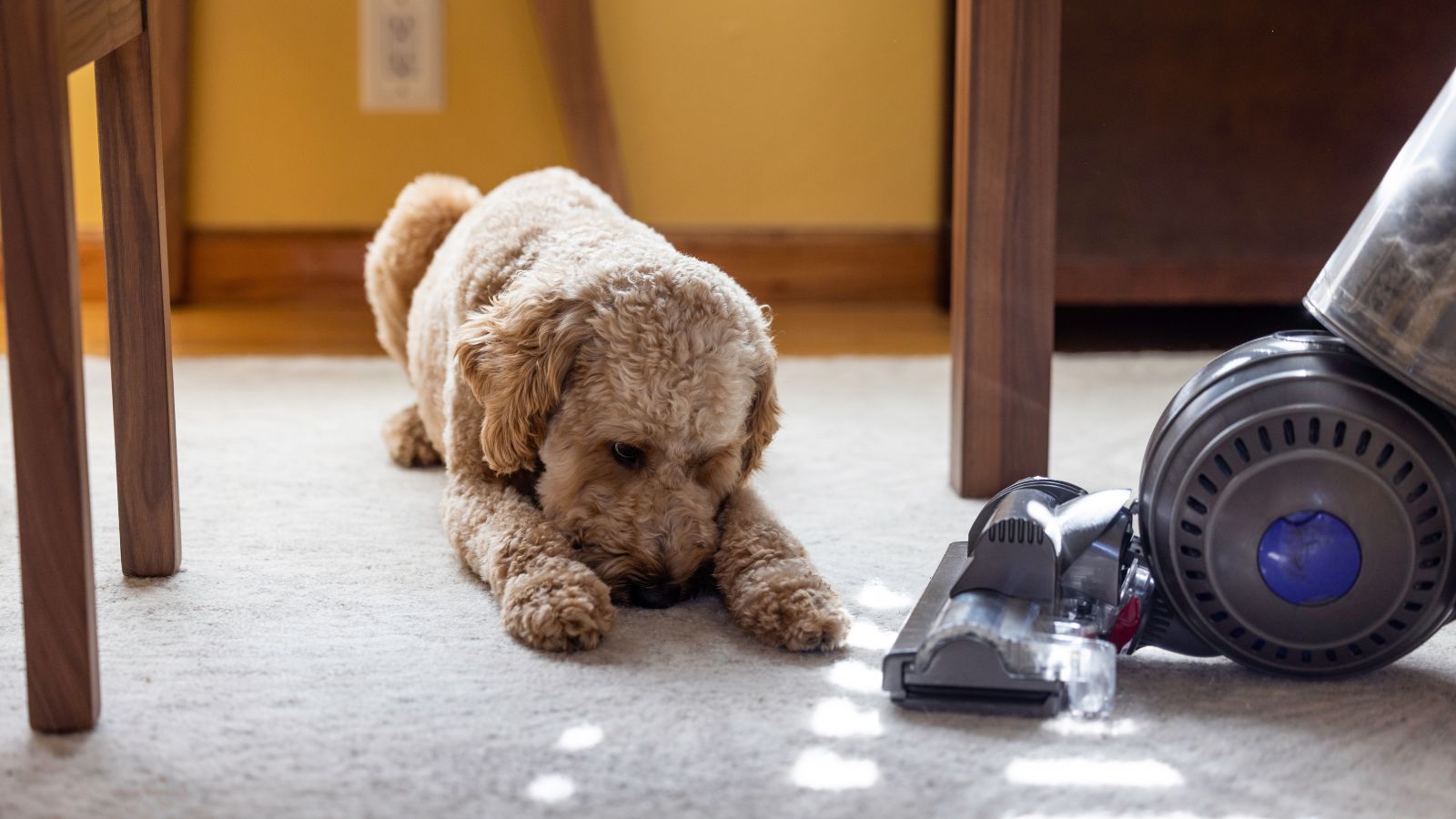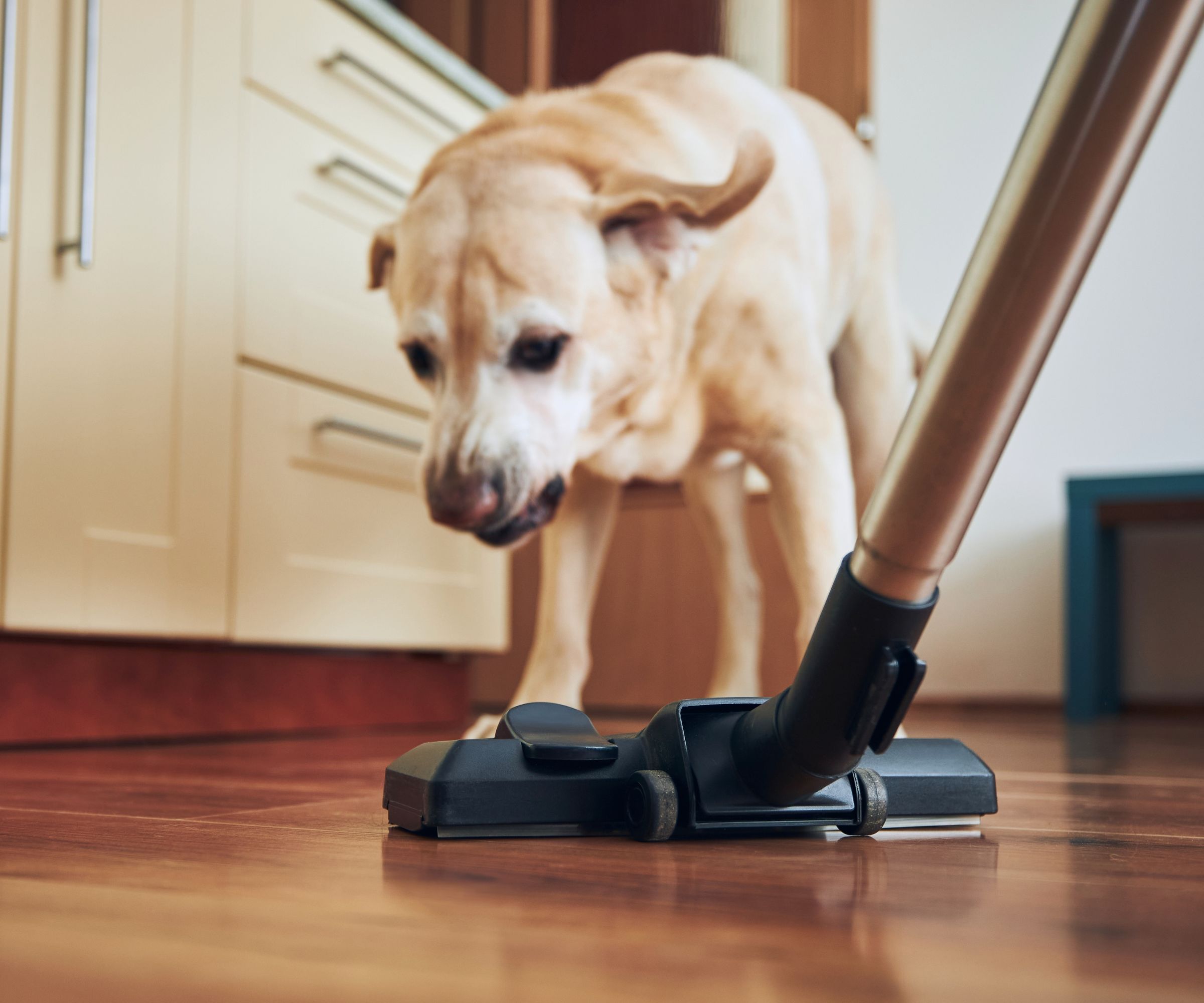
If you were the size of your dog, then a loud, heavy vacuum would likely be pretty scary to you too. Nevertheless, if your dog is scared of the vacuum, it can cause severe stress and anxiety, both for your animal and for you.
If you are frequently in fear of getting your vacuum for pet hair out for the sake of your dog, it can be hard to keep on top of your housework, leading to a disheveled-looking space.
The good news is that expert animal behaviorists have years of experience in acclimatizing our pets to worrying situations, and they are more than happy to share their advice.
What to do if your dog is scared of your vacuum
We have spoken to top animal behaviorists to hear their thoughts on what to do if your dog is scared of the vacuum.
Why dogs are scared of vacuums

When living with pets, it is important to follow some strict cleaning tips to help keep your space in order. Dog and pet hair quickly becomes embedded in carpet and upholstery, floats around wooden floors, and dander build-up can cause allergy symptoms even in those who are not allergic. Vacuuming often can be difficult if you have a dog that is terrified of vacuum cleaners, however.
‘A fear of the vacuum cleaner is actually very common in dogs,’ explains Susan Nilson, qualified cat and dog behavioral expert and founder of The Cat and Dog House. ‘Many dogs are terrified of loud noises and noise phobias, such as a fear of fireworks or thunderstorms, are also extremely common. And not only is a vacuum cleaner extremely noisy, it also moves in an unpredictable way,’ she adds.
A fear of a vacuum could be worse for rescue dogs or dogs from shelters, Susan adds. ‘These dogs have little experience of life in a home and will have no idea what the vacuum cleaner is and will quite understandably be extremely wary around it. It may even evoke bad memories of life outside.’
How to acclimate your dog to the vacuum

Given that you can't remove the vacuum entirely, you can make your home more pet friendly by helping them acclimatize to the loud sounds and bulky shape. These two processes are called desensitization and counter-conditioning,’ says Jennifer Malawey, dog trainer and behavior consultant.
‘Desensitization involves gradually increasing the dog's exposure to the scary stimulus, while counter-conditioning pairs it with positive things, like high-value treats or playtime, so the dog learns to view it positively instead of negatively,’ continues Susan Nilson, qualified cat and dog behaviorist. One great way to incorporate these techniques into your routines is to create a training schedule, she recommends.
- Identify your dog's limits: Identify the threshold distance at which the dog has no reaction to the vacuum cleaner. Keep it switched off to start with.
- Begin with basic exposure therapy: Gradually increase the length of time the dog can see the vacuum from a distance where they are comfortable, over several training sessions.
- Use positive association from the start: At the same time, use counter-conditioning to help your dog develop a positive association with the vacuum by pairing its presence with highly coveted treats or his favorite toy – ideally something utterly fabulous that they absolutely love and don't get access to at any other time. A top-rated option are the Ziwi Peak Good Dog Training Treats, available at Amazon. They are grain-free, all-natural, and perfect for puppies to elders.
- Increase how long you present the vacuum at a time: Continue to pair good things with the presence of the vacuum cleaner as you increase the time they are exposed to its presence while decreasing the distance.
- Try turning the vacuum on: Once your pup is comfortable with the vacuum at a closer distance, you can turn it on for a nanosecond, reward them profusely at the same time (think raining down yummy treats), then turn it off again. Repeat this several times, gradually building up the amount of time the vacuum is switched on.
- Add in movement: Once they can handle this you can start moving it around for a few seconds and gradually build up the amount of time you do that, based on the dog's responses. And keep rewarding calm behavior!
‘Training sessions can be brief, just a few minutes or even seconds. Always end on a high note and don't be tempted to rush,’ Susan recommends. ‘It is essential to go at the dog’s pace during each training session, making only very gradual increases in duration and distance. It's important to watch the dog's body language for signs of stress.
'Dogs can give many signs if they are feeling stressed, including freezing or a stiffening of the body or facial muscles, ears back, hunched posture, whites of the eyes showing, raised hackles, panting, yawning, lip licking, tongue flicking, turning the head away, or removing themselves altogether to avoid the unpleasant situation. Some dogs will even try to hide,' she says.
Any of these signs show you that you have gone too far too quickly and need to go back a few steps to where you see loose, calm, relaxed body language. Take a break and then next time start your training from there. A few good seconds are far better than a stressful few minutes.
What to do if vacuuming continues to cause anxiety

If your dog takes a long time to adjust, or continues to struggle with the vacuum and you need to get dog hair out of carpet, then there are a few things you can do to keep a clean home without raising tensions.
‘One option is to protect your dog from the anxiety,’ begins Jennifer Malawey, dog trainer and behavior consultant. ‘The best thing to do is to vacuum while your dog is out of the house on a walk, at daycare, or with a friend. Some dogs may cope just fine in the other room when you vacuum, but make sure they're not just panicking in another part of the house.’
‘At the same time, you can put on some background music (studies show that dogs find classical music the most relaxing) or even some music specifically designed for calming canine anxiety,’ Susan Nilson, pet behaviorist adds. ‘This will mask the sound a little bit. At the same time, give your dog a food puzzle toy to present them with a mental challenge and make them engage their brain.
'The more they engage their rational brain, the more inhibited their emotional brain will be, which will help them stay calmer. You may even want to plug in a canine pheromone diffuser, at Amazon. It may or may not work, but it's worth a try to help them stay relaxed.’
It may be a good idea to invest in a good handheld vacuum for pet hair to make it a little easier to tackle smaller areas while reducing stress on your dog. This one by Bissell is one of our favorite handheld options on the market:
FAQs
Is my dog trying to protect me from the vacuum?
If you find that your dog tries to lunge or attack the vacuum, it may be that they are trying to protect you from it. This may be because they perceive the vacuum as a threat and, instead of running away from it, try to battle it head on with nipping, barking, or herding.
How often should you vacuum your house with dogs?
If you have dogs, it is a good idea to vacuum your home at least one to two times a week, increasing that amount if you have a long-haired dog, a dog prone to shedding, or someone in the house who has allergies. Consider picking a good vacuum for pet hair to help pick up the most amount of hair from deep in carpet fibers.
It is natural for a dog to be scared of a vacuum, but there are some good training tips to help alleviate their anxiety and help them get used to the loud sounds and bulky appearance of your vacuum cleaner.







